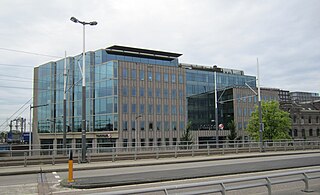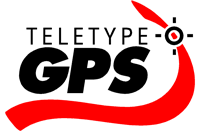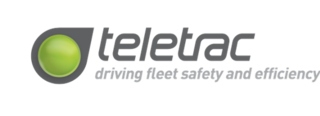
Traffic Message Channel (TMC) is a technology for delivering traffic and travel information to motor vehicle drivers. It is digitally coded using the ALERT C or TPEG protocol into Radio Data System (RDS) carried via conventional FM radio broadcasts. It can also be transmitted on Digital Audio Broadcasting or satellite radio. TMC allows silent delivery of dynamic information suitable for reproduction or display in the user's language without interrupting audio broadcast services. Both public and commercial services are operational in many countries. When data is integrated directly into a navigation system, traffic information can be used in the system's route calculation.
Garmin Ltd. is an American, Swiss-domiciled multinational technology company founded in 1989 by Gary Burrell and Min Kao in Lenexa, Kansas, United States, with headquarters in Olathe, Kansas. Since 2010, the company is legally incorporated in Schaffhausen, Switzerland.

An automotive navigation system is part of the automobile controls or a third party add-on used to find direction in an automobile. It typically uses a satellite navigation device to get its position data which is then correlated to a position on a road. When directions are needed routing can be calculated. On the fly traffic information can be used to adjust the route.
Mio Technology Corporation, a subsidiary of MiTAC International Corporation, is a Taiwanese electronics maker that manufactures and markets pocket PCs, personal digital assistants (PDAs), smartphones and personal navigation devices (PNDs). It sells products under the "Navman" and "Mio" brands.
Leadtek Research, Inc. is a Taiwanese company, founded in 1986, which focuses on research and development that is specialized in the design and manufacture of graphics cards.

TomTom N.V. is a Dutch multinational developer and creator of location technology and consumer electronics. Founded in 1991 and headquartered in Amsterdam, TomTom released its first generation of satellite navigation devices to market in 2004. As of 2019 the company has over 4,500 employees worldwide and operations in 29 countries throughout Europe, Asia-Pacific, and the Americas.

Telit Cinterion is an Internet of Things (IoT) Enabler company headquartered in Irvine, California, United States. It is a privately held company with key operations in the US, Brazil, Italy, Israel, and Korea.
NavPix is the proprietary name applied by Navman to its technology that combines an image with geographical data.

MiTAC Holdings Corporation, formerly MiTAC International Corp. is a Taiwanese electronics company established 8 December 1982. It is a subsidiary of MiTAC-Synnex Group. Through a 100% stock swap from MiTAC International Corp., MiTAC Holdings Corp (神達投資控股) was established on 12 September 2013, and listed and traded on Taiwan Stock Exchange under code 3706.

The HTC TyTN II is an Internet-enabled Windows Mobile Pocket PC smartphone designed and marketed by HTC Corporation of Taiwan. It has a tilting touchscreen with a right-side slide-out QWERTY keyboard. The TyTN II's functions include those of a camera phone and a portable media player in addition to text messaging and multimedia messaging. It also offers Internet services including e-mail, instant messaging, web browsing, and local Wi-Fi connectivity. It is a quad-band GSM phone with GPRS, EDGE, UMTS, HSDPA, and HSUPA.

Navigon GmbH was a Würzburg, Germany-based manufacturer of GPS devices and GPS navigation software. The company was privately owned, until in June 2011, it was announced that Navigon was to be acquired by Garmin and become a subsidiary of the company. With effect from October 31, 2011, Navigon has changed its legal entity from corporation (Aktiengesellschaft) to GmbH.

The Samsung SGH-i900, also known as Omnia I or WiTu, is a smartphone created by Samsung Mobile. Announced in June 2008, the Omnia was launched in Singapore in mid-June, available in stores on the 20th of June, and in the rest of Asia in July. For some parts of Europe, it was launched in August. It was made available for the United States in December 2008 through Verizon Wireless and for Canada in April 2009 through Telus Mobility.
GeoSmart (NZ) Ltd is a provider of location-based services, digital mapping data and images for the Oceania area, notably New Zealand. The company is one of only a handful of global companies producing digital maps for use in GPS applications. GeoSmart was acquired by TomTom in 2014.

TeleType Co., Inc. is a privately held company in the United States, specialized in developing software for GPS devices. It was founded in 1981, under the name TeleTypesetting Company and it is based in Boston, Massachusetts. The company's product line includes automotive and commercial GPS navigation systems and other products including GPS receivers and tracking units. It develops and sells the WorldNav software for PC and Windows CE, tools for converting third party maps into WorldNav maps, an SDK and an API that allow the customization of the WorldNav application. TeleType Co. also offers consultancy services for those interested in acquiring and adapting the source code of their software products.
Telenav, Inc. is a wireless location-based services corporation that provides services including Global Positioning System (GPS) satellite navigation, local search, automotive navigation solutions, mobile advertising, enterprise mobility and workflow automation. The company’s headquarters are located in Santa Clara, California in the United States with additional offices in the U.S., Germany, Japan, Romania, China, and Brazil.
MyLink a.k.a. Intellilink is a telematics system/infotainment system offered by General Motors in their vehicles. The system was debuted in 2011 in the then-new Chevrolet Volt.

NNG, formerly known as Nav N Go is a company which provides navigation software for the automotive, enterprise, wireless and personal navigation industries. In 2016, NNG had nearly 1000 employees, 12 offices and 4 auxiliary offices on 6 continents. NNG's products are based on the iGO Navigation Engine, which consists of the navigation software, user interfaces, and related content and services, which it sells to device manufacturers, auto makers, network operators, and transport specialist companies.

Teletrac is a software as a service company headquartered in Southern California, with offices in the United Kingdom. It provides cloud-based GPS fleet tracking software, stolen vehicle tracking and connected services such as eCall, bCall and Concierge and is a subsidiary of Vontier.
MiTAC Holdings Corporation, through its subsidiaries, provides GPS navigation devices, automotive solution, cloud services and cloud computing products worldwide. The company offers a range of electronics manufacturing services, such as research and development, design, manufacturing, assembly, marketing, and solutions. It also distributes portable car navigation products, outdoor handheld navigation devices, and mobile GPS solutions; and DashCam for vehicles, portable navigation devices for 4WD, and trucks under the Magellan, Mio, and Navman brand names. In addition, the company designs, manufactures, and markets x86 server/workstation platforms to OEMs, VARs, system integrators, and resellers under the TYAN brand name. Further, it offers storage products, cloud computing applications, all-in-one PC, thin client, and POS system, as well as smart wearable device and professional tablet series. MiTAC Holdings Corporation is based in Taipei, Taiwan.













